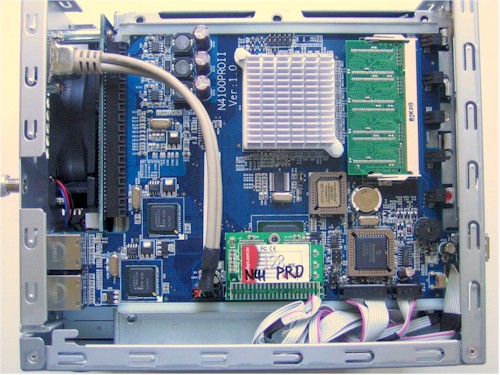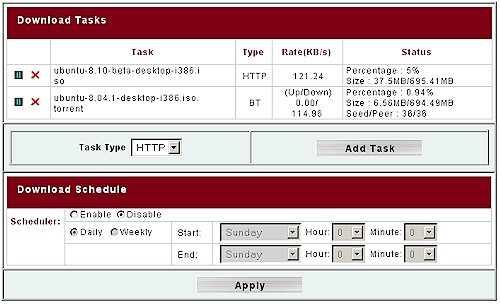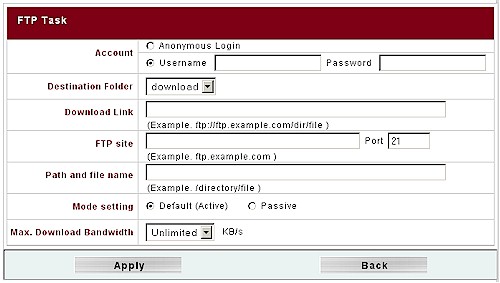Introduction
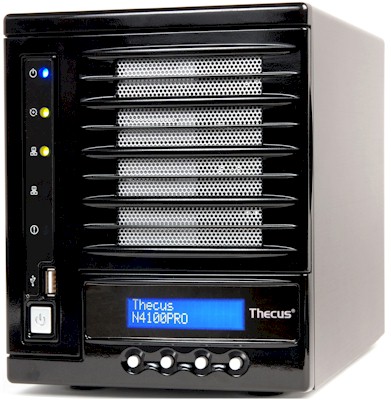
| At a Glance | |
|---|---|
| Product | Thecus NAS Server (N4100 Pro) |
| Summary | Four drive version of the N5200 Pro based on AMD Geode LX800 |
| Pros | • Hot-swappable drives • NFS, AFP support • iTunes, UPnP AV, Print servers • HTTP/FTP/BT Download client |
| Cons | • User Interface still a bit rough • Unbalanced write and read speed • Can’t upgrade relatively small RAM w/o violating warranty |
While we wait for Atom-based NASes to start popping out the delivery canals of U.S. NAS makers (yes, I know about the Tranquil PC SQA-5H Home Server), Thecus has already delivered its N4100 Pro (4100P), which uses AMD’s Geode LX800. I won’t get into a fanboy flame war over the merits of the Geode vs. the Atom. But instead I’ll let the 4100P’s performance speak for itself.
You can think of the N4100 Pro as a four-drive version of the N5200 Pro, minus the iSCSI support and eSATA connector and with some new features such as an iTunes server and Download Manager that I’ll get to in a bit.
The 4100P’s enclosure is a little nicer looking than the 5200’s, with a swing-away door screening the four drive trays. Serviceability looks decent—the entire cover removes with three captive thumbscrews on the rear panel, revealing a motherboard that plugs into the drive backplane and sits in clear view on the left side of the case. Getting at the power supply will take a bit of doing; it looked to me like the whole assembly would need to be taken apart.
Figure 1 shows the front panel controls and indicators. You get the same LCD panel and four navigation buttons from the N5200 Pro and a USB 2.0 connector. Instead of a dedicated button for the USB Copy function, you push the 4100P’s Enter button instead.
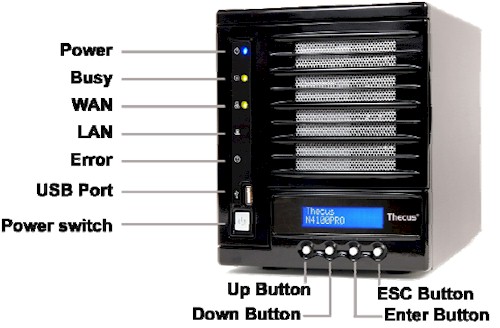
Figure 1: Front Panel
The rear panel (Figure 2) shows some simplification from the 5200. Gone are the eSATA, type B USB 2.0 and serial ports. But you still get two 10/100/1000 Ethernet ports, which can be configured to serve separate LANs or into failover or link-aggregation modes.
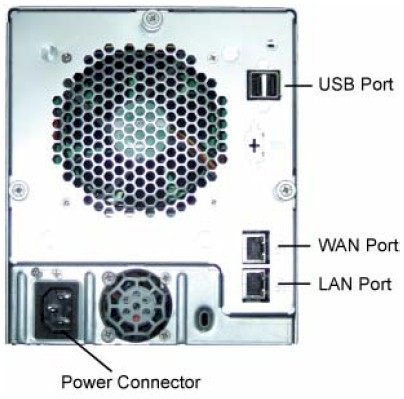
Figure 2: Back Panel
Internal Details
The 4100P’s innards are shown in Figure 3, where you can see the AMD Geode LX800 CPU under the heatsink at the top of the board. The rather meager 256 MB of DDR400 memory sits on the SODIMM at the top right, which is inserted into a single connector. Although it’s easy to change this memory, Thecus tells me that doing so will void your warranty, so you have been warned!
Figure 3: N4100 Pro inside view
Two Intel 82541 gigabit Ethernet controllers for the WAN and LAN port are at the lower left, with a 128 MB IDE Flash drive to their right. Just peeking over the top of the IDE Flash drive is an AMD Geode CS5536 Companion Device, which handles IDE, USB 2.0, audio and other miscellaneous I/O duties.
There is also a Phoenix E686 BIOS chip in one of the sockets and a Microchip PIC16F877A 8 bit microcontroller in the other. In case you’re looking for the SATA controller, the Silicon Image SiI3114CTU PCI to 4 Port SATA150 is on the back of the board.
The motherboard plugs into the drive backplane via the black connector at top left. The backplane provides blind-mate connection to four 3.5″ SATA drives, which are formatted using a standard ext3 filesystem. Drives up to 1 TB are supported (a PDF list of supported drives can be downloaded here).
The system is very quiet in operation. The only time I heard fan noise was during bootup when the system briefly revs the fan to full speed then ramps it back down. I measured power draw for a system loaded with four WDC WD1600AAJS-0 Caviar Blue drives (160 GB, 3 Gb/s, 8 MB Cache, 7200 RPM, provided by Thecus) with my trusty KillAWatt meter at 49 W active and / 26 W when the Disk Power Management feature (idle disk spin down) kicked in.
Features
To achieve its lower price point, the 4100P dispenses with some of the 5200P’s features. As noted earlier, you don’t get the eSATA port. But more notably, the 4100P does not support iSCSI, which means you don’t get the 5200P’s Stackable feature, either.
The good news, however, is that the 4100P still delivers most of the other handy features found in its bigger siblings, such as online RAID expansion and RAID level migration. You also get Thecus’ proprietary nsync system-to-system backup and ISO Mount feature that lets you share.ISO files stored on the 4100P as read-only share folders.
For media mavens, Thecus has included the same Mediabolic UPnP AV media server that was added to the 5200P. But the latest 2.01.04 firmware has added an iTunes server, as well (Figure 4).
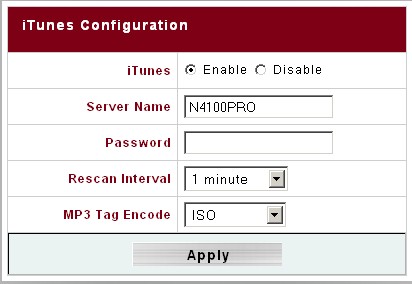
Figure 4: iTunes Server
The Rescan Interval can be set to 1, 10, 30 or 60 minutes or 1 day and the MP3 Tag Encode control provides ISO, BIG5, GBK, GB2312, GB18030, EUC-JP, SHIFT-JIS, EUK-KR and UTF-8 alternatives. When you first enable the server, it silently and automatically creates an iTunes_music folder that is publicly browseable (the revised User Manual incorrectly identifies the folder as Music).
I found, however, that I wasn’t able to access the new folder until I rebooted the 4100P. After a reboot, I was able to copy over a couple of folders of MP3 files, which iTunes found and played with no problem.
Another new feature is the Download Manager that supports HTTP, FTP and BitTorrent downloads. Figure 5 shows a Torrent and HTTP download in progress. You can start and pause downloads and remove them entirely, but can’t edit them, even if they haven’t been started.
Figure 5: Download Manager Status
I initially got an "Unable to Resolve Address" message when I tried to start the HTTP download, which I eventually traced to the fact that I had not entered a DNS Server when I manually entered the 4100P’s IP address information. Once I did that and rebooted, the download started without a problem. Note, however, that the BT download did not throw an error under the same condition, but just showed no download activity.
Figure 6 shows the screen for adding a Download Manager FTP task. Note that it handles authenticated and anonymous downloads as well as active and passive FTP. Secure FTP isn’t handled however. Each of the download methods, by the way, have bandwidth limiting controls.
Figure 6: FTP download task add
The BitTorrent add screen also provides Max (50) and Min (20) Peer Count controls and separate banwidth limits for up and downloading. The HTTP screen is the simplest, with just URL, destination folder and download bandwidth limits. So authenticated or secure HTTP downloads are not handled.
The Scheduled Power down feature that was added to the 5200P is also present in the 4100P. I tried it out and it worked fine, with the system drawing on 3 W while sleeping. With email alerts enabled, I found that the 4100P sent a message before shutdown and after startup. You also get a warning on the LCD panel that warns you that the system is shutting down, but not a warning beep.
The 4100P also has a Photo Server feature similar to the one on the N3200. I played with it a bit at it looks to be pretty much the same. The release notes say that support has been added for IP Cameras. But I could find no sign of it in either the web admin interface or the revised user manual.
Performance
I used IOzone to check out the file system performance on the 4100P (the full testing setup and methodology are described on this page). Thecus supplied the product with four 160 GB Western Digital Caviar Blue hard drives (WD1600AAJS, 3 Gb/s, 8 MB Cache, 7200 RPM). My test unit had the latest 2.01.04 firmware and I used default RAID settings, which included a 64 KB stripe size.
I ran tests with the 4100P configured in RAID 0, 5 and 10 modes, with 100 Mbps, 1000 Mbps and 1000 Mbps w/ 4K jumbo frame LAN connection.
Figure 7 shows a summary of the product’s large filesize write test results with 1000 Mbps and 1000 Mbps w/ 4K jumbo frame LAN connections. I didn’t bother plotting 100 Mbps results, because they are held back by the slower LAN speed.
RAID 5 seems to get the least benefit from using jumbo frames and RAID 0 and 10 about the same. Average write speed across the large file sizes came in at 23.5, 18.7 and 23.9 MB/s for RAID 0, 5 and 10 respectively with the gigabit connection and 27.5, 20.4 and 24.5 MB/s for 4k jumbo frames.
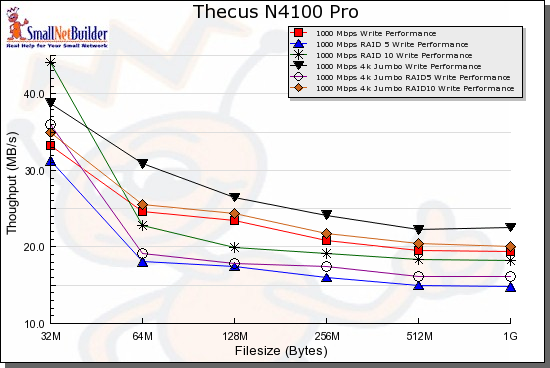
Figure 7: N4100 Pro write benchmark comparison
Figure 8 shows large filesize read results, which are harder to follow. But it seems like read performance benefits much less from jumbo frames than the write.
Average read speed across the large file sizes came in at 43.3, 39.0 and 41.6 MB/s for RAID 0, 5 and 10 respectively with the gigabit connection and 44.4, 40.3 and 41.2 MB/s for 4k jumbo frames. The plots show that Reads not only reach higher maximum speeds in the 50 MB/s range, but stay up longer than writes.
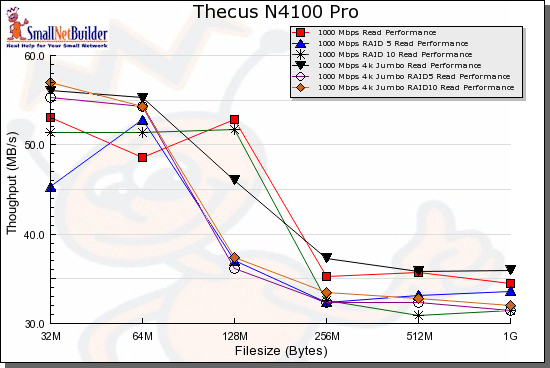
Figure 8: N4100 Pro read benchmark comparison
Performance – Competitive Comparison
The 4100P doesn’t rank near the top of the current NAS charts, which are dominated by products with Intel CPUs, more memory and RAID 5 write speeds in the 40 – 50 MB/s range. Instead, it sits near the top of the RAID 5 middle group that has speeds in the mid to high teens.
So the comparison products I chose came from that group and include the QNAP TS-409 Pro, Synology DS408 and D-Link DNS-343. The DNS-343 is closest to the 4100P in price, with both coming in around $420. The Qnap and Synology pricing reflects their abundance of features and premium product positioning with prices around $580 and $850 (!) respectively.
Figure 9 shows the DS408 clearly outperforming the 4100P and other products for RAID 5 write with a gigabit LAN connection. The other products are pretty evenly matched for filesizes from 64 MB on up.
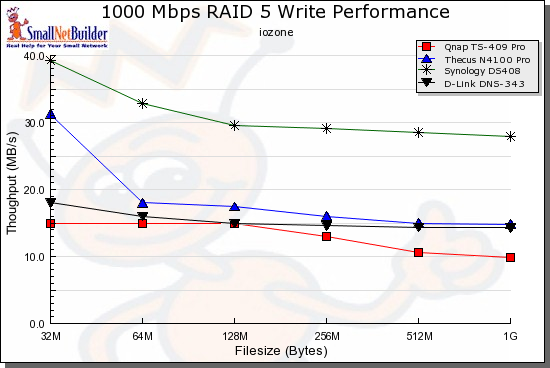
Figure 9: Competitive comparison – RAID 5 write, 1000 Mbps
Figure 10 compares RAID 5 read performance under the same conditions with the DS408 once again taking the top position. But the 4100P makes a better showing this time, coming in at second place.
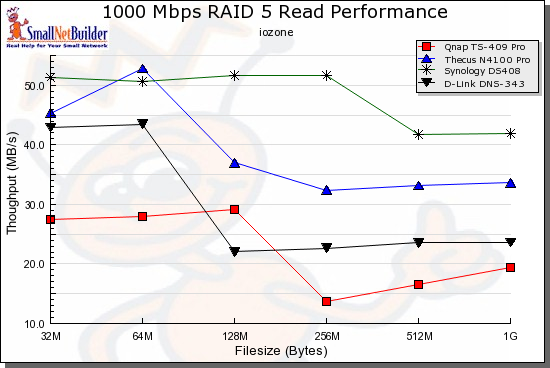
Figure 10: Competitive comparison – RAID 5 read, 1000 Mbps
So the Synology DS408 is the clear winner in this comparison, but at almost twice the price of the 4100P!
Closing Thoughts
The 4100P brings Thecus’ four-drive offering up to date hardware-wise with the refreshed quad-drives from QNAP and Thecus. In terms of features, however, it ranks above the D-Link DNS-343, but below the QNAP and Synology products, both of which seem to be in a steel-cage death match to cram the most features into their NASes.
Thecus’ product line still has a web GUI that only an engineer could love; a quality that QNAP’s GUI seems to share. In contrast, Synology has clearly broken away from the trio with its AJAX-based DSM2.0 GUI. But in the end, all three interfaces will let you get the job done and probably won’t be the deciding factor in your choice.
If you have been thinking about a D-Link DNS-343, but are looking for a bit more in the feature department, you might want to add the 4100 Pro to your short list. But only if you’re comfortable with a smaller company and don’t mind hunting around and dealing with lesser-known etailers to find product.

